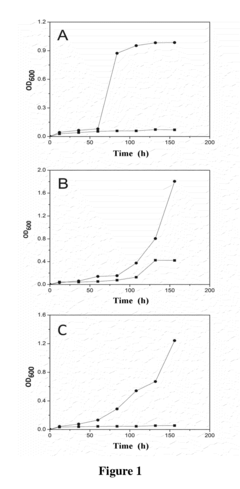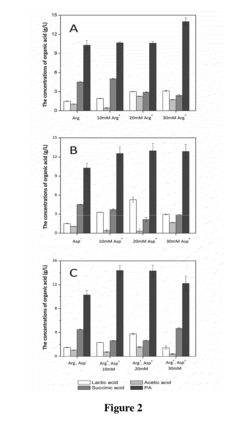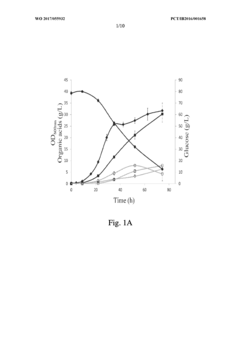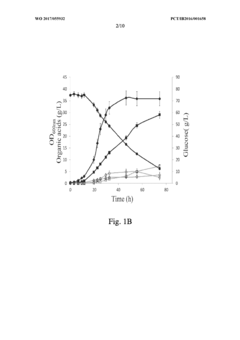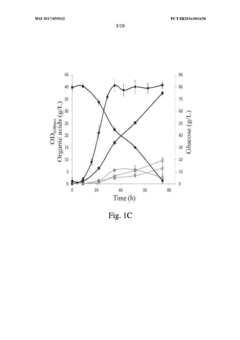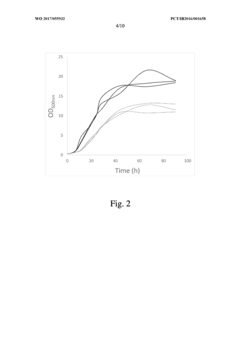How to Drive Innovation with Propionic Acid in Material Sciences?
JUL 3, 20259 MIN READ
Generate Your Research Report Instantly with AI Agent
Patsnap Eureka helps you evaluate technical feasibility & market potential.
Propionic Acid in Materials: Background and Objectives
Propionic acid, a versatile organic compound, has been gaining significant attention in the field of material sciences due to its unique properties and potential applications. This carboxylic acid, with its simple structure and reactive nature, has been utilized in various industries for decades, primarily in food preservation and as a precursor for other chemicals. However, its role in material sciences has been evolving rapidly, opening up new avenues for innovation and technological advancements.
The journey of propionic acid in material sciences can be traced back to its initial use as a plasticizer and additive in polymer production. Over time, researchers and industry professionals have recognized its potential to enhance material properties, improve manufacturing processes, and create novel materials with superior characteristics. This realization has led to a surge in research and development activities focused on harnessing the full potential of propionic acid in material sciences.
The primary objective of exploring propionic acid in material sciences is to drive innovation by leveraging its unique chemical and physical properties. These properties include its ability to form strong hydrogen bonds, its relatively low molecular weight, and its capacity to participate in various chemical reactions. By exploiting these characteristics, researchers aim to develop new materials with enhanced performance, durability, and functionality across a wide range of applications.
One of the key areas of focus is the development of sustainable and eco-friendly materials. Propionic acid, being a naturally occurring compound, aligns well with the growing demand for green chemistry and environmentally responsible manufacturing processes. Researchers are exploring ways to incorporate propionic acid into biodegradable polymers, composite materials, and coatings that offer improved environmental profiles without compromising on performance.
Another significant objective is to enhance the properties of existing materials. By utilizing propionic acid as a modifier or additive, scientists are working on improving the mechanical strength, thermal stability, and chemical resistance of various materials. This includes efforts to develop advanced composites, high-performance plastics, and innovative surface treatments that can withstand harsh environmental conditions and extend the lifespan of products.
The exploration of propionic acid in material sciences also aims to unlock new functionalities in materials. This includes the development of smart materials that can respond to external stimuli, self-healing materials that can repair damage autonomously, and materials with improved barrier properties for packaging and protective applications. The versatility of propionic acid makes it an attractive candidate for creating multifunctional materials that can address complex challenges in various industries.
As we delve deeper into the potential of propionic acid in material sciences, it becomes evident that this field is at the cusp of significant breakthroughs. The ongoing research and development efforts are not only pushing the boundaries of material science but also paving the way for innovative solutions to some of the most pressing challenges in sustainability, energy efficiency, and advanced manufacturing.
The journey of propionic acid in material sciences can be traced back to its initial use as a plasticizer and additive in polymer production. Over time, researchers and industry professionals have recognized its potential to enhance material properties, improve manufacturing processes, and create novel materials with superior characteristics. This realization has led to a surge in research and development activities focused on harnessing the full potential of propionic acid in material sciences.
The primary objective of exploring propionic acid in material sciences is to drive innovation by leveraging its unique chemical and physical properties. These properties include its ability to form strong hydrogen bonds, its relatively low molecular weight, and its capacity to participate in various chemical reactions. By exploiting these characteristics, researchers aim to develop new materials with enhanced performance, durability, and functionality across a wide range of applications.
One of the key areas of focus is the development of sustainable and eco-friendly materials. Propionic acid, being a naturally occurring compound, aligns well with the growing demand for green chemistry and environmentally responsible manufacturing processes. Researchers are exploring ways to incorporate propionic acid into biodegradable polymers, composite materials, and coatings that offer improved environmental profiles without compromising on performance.
Another significant objective is to enhance the properties of existing materials. By utilizing propionic acid as a modifier or additive, scientists are working on improving the mechanical strength, thermal stability, and chemical resistance of various materials. This includes efforts to develop advanced composites, high-performance plastics, and innovative surface treatments that can withstand harsh environmental conditions and extend the lifespan of products.
The exploration of propionic acid in material sciences also aims to unlock new functionalities in materials. This includes the development of smart materials that can respond to external stimuli, self-healing materials that can repair damage autonomously, and materials with improved barrier properties for packaging and protective applications. The versatility of propionic acid makes it an attractive candidate for creating multifunctional materials that can address complex challenges in various industries.
As we delve deeper into the potential of propionic acid in material sciences, it becomes evident that this field is at the cusp of significant breakthroughs. The ongoing research and development efforts are not only pushing the boundaries of material science but also paving the way for innovative solutions to some of the most pressing challenges in sustainability, energy efficiency, and advanced manufacturing.
Market Analysis for Propionic Acid-Based Materials
The market for propionic acid-based materials is experiencing significant growth, driven by increasing demand across various industries. The global propionic acid market size was valued at approximately $1.5 billion in 2020 and is projected to reach $2.1 billion by 2027, growing at a CAGR of around 5.2% during the forecast period. This growth is primarily attributed to the expanding applications of propionic acid in food preservation, pharmaceuticals, and material sciences.
In the material sciences sector, propionic acid-based materials are gaining traction due to their unique properties and versatile applications. The market for these materials is expected to witness substantial growth, particularly in the production of biodegradable plastics, coatings, and adhesives. The increasing focus on sustainable and eco-friendly materials is a key driver for this market segment, as propionic acid-based materials offer biodegradability and reduced environmental impact compared to traditional petroleum-based alternatives.
The food industry remains the largest consumer of propionic acid-based materials, accounting for approximately 60% of the market share. The use of propionic acid as a food preservative and mold inhibitor in bakery products, cheese, and animal feed is expected to continue driving demand. Additionally, the pharmaceutical industry is emerging as a significant market for propionic acid-based materials, with applications in drug formulations and as intermediates in the synthesis of various pharmaceutical compounds.
Geographically, North America and Europe are the leading markets for propionic acid-based materials, collectively accounting for over 50% of the global market share. However, the Asia-Pacific region is expected to witness the highest growth rate in the coming years, driven by rapid industrialization, increasing disposable income, and growing awareness of sustainable materials in countries like China and India.
The market for propionic acid-based materials faces some challenges, including volatility in raw material prices and competition from alternative preservatives and materials. However, ongoing research and development efforts are focused on expanding the application scope of these materials, which is expected to create new growth opportunities. Innovations in bio-based production methods for propionic acid are also likely to positively impact the market by reducing production costs and improving sustainability.
Key players in the propionic acid-based materials market include BASF SE, Dow Inc., Eastman Chemical Company, and Perstorp Holding AB. These companies are investing in research and development to create novel applications and improve the performance of propionic acid-based materials, further driving market growth and innovation in the material sciences sector.
In the material sciences sector, propionic acid-based materials are gaining traction due to their unique properties and versatile applications. The market for these materials is expected to witness substantial growth, particularly in the production of biodegradable plastics, coatings, and adhesives. The increasing focus on sustainable and eco-friendly materials is a key driver for this market segment, as propionic acid-based materials offer biodegradability and reduced environmental impact compared to traditional petroleum-based alternatives.
The food industry remains the largest consumer of propionic acid-based materials, accounting for approximately 60% of the market share. The use of propionic acid as a food preservative and mold inhibitor in bakery products, cheese, and animal feed is expected to continue driving demand. Additionally, the pharmaceutical industry is emerging as a significant market for propionic acid-based materials, with applications in drug formulations and as intermediates in the synthesis of various pharmaceutical compounds.
Geographically, North America and Europe are the leading markets for propionic acid-based materials, collectively accounting for over 50% of the global market share. However, the Asia-Pacific region is expected to witness the highest growth rate in the coming years, driven by rapid industrialization, increasing disposable income, and growing awareness of sustainable materials in countries like China and India.
The market for propionic acid-based materials faces some challenges, including volatility in raw material prices and competition from alternative preservatives and materials. However, ongoing research and development efforts are focused on expanding the application scope of these materials, which is expected to create new growth opportunities. Innovations in bio-based production methods for propionic acid are also likely to positively impact the market by reducing production costs and improving sustainability.
Key players in the propionic acid-based materials market include BASF SE, Dow Inc., Eastman Chemical Company, and Perstorp Holding AB. These companies are investing in research and development to create novel applications and improve the performance of propionic acid-based materials, further driving market growth and innovation in the material sciences sector.
Current Challenges in Propionic Acid Applications
Despite the widespread use of propionic acid in various industries, several challenges persist in its applications within material sciences. One of the primary obstacles is the corrosive nature of propionic acid, which limits its compatibility with certain materials and equipment. This corrosiveness can lead to increased maintenance costs and potential safety hazards in industrial settings.
Another significant challenge is the volatility of propionic acid, which can result in loss of product during processing and storage. This not only affects the efficiency of production processes but also raises environmental concerns due to potential emissions. Developing effective containment and handling methods remains a crucial area for improvement.
The production cost of propionic acid is another hurdle in its widespread adoption in material sciences. Current manufacturing processes are energy-intensive and often rely on petrochemical feedstocks, which are subject to price fluctuations. This economic factor can hinder the scalability of propionic acid applications, particularly in cost-sensitive industries.
Furthermore, the purity levels required for certain high-end applications in material sciences are challenging to achieve consistently. Impurities can significantly affect the performance of propionic acid in advanced materials, necessitating sophisticated purification techniques that add to the overall production costs.
There is also a growing demand for sustainable and bio-based alternatives to traditional propionic acid production methods. However, developing economically viable and environmentally friendly processes that can match the efficiency of conventional methods remains a significant challenge.
In the realm of polymer science, incorporating propionic acid or its derivatives into polymer matrices while maintaining desired material properties poses technical difficulties. Issues such as phase separation, uneven distribution, and potential degradation of the polymer structure during processing need to be addressed.
Lastly, regulatory challenges and varying global standards for the use of propionic acid in different applications create complexities for manufacturers and researchers. Navigating these regulatory landscapes while innovating new applications requires significant resources and expertise.
Addressing these challenges will be crucial for driving innovation with propionic acid in material sciences. Overcoming these hurdles could unlock new possibilities in areas such as biodegradable plastics, advanced coatings, and novel composite materials, potentially revolutionizing various sectors of the materials industry.
Another significant challenge is the volatility of propionic acid, which can result in loss of product during processing and storage. This not only affects the efficiency of production processes but also raises environmental concerns due to potential emissions. Developing effective containment and handling methods remains a crucial area for improvement.
The production cost of propionic acid is another hurdle in its widespread adoption in material sciences. Current manufacturing processes are energy-intensive and often rely on petrochemical feedstocks, which are subject to price fluctuations. This economic factor can hinder the scalability of propionic acid applications, particularly in cost-sensitive industries.
Furthermore, the purity levels required for certain high-end applications in material sciences are challenging to achieve consistently. Impurities can significantly affect the performance of propionic acid in advanced materials, necessitating sophisticated purification techniques that add to the overall production costs.
There is also a growing demand for sustainable and bio-based alternatives to traditional propionic acid production methods. However, developing economically viable and environmentally friendly processes that can match the efficiency of conventional methods remains a significant challenge.
In the realm of polymer science, incorporating propionic acid or its derivatives into polymer matrices while maintaining desired material properties poses technical difficulties. Issues such as phase separation, uneven distribution, and potential degradation of the polymer structure during processing need to be addressed.
Lastly, regulatory challenges and varying global standards for the use of propionic acid in different applications create complexities for manufacturers and researchers. Navigating these regulatory landscapes while innovating new applications requires significant resources and expertise.
Addressing these challenges will be crucial for driving innovation with propionic acid in material sciences. Overcoming these hurdles could unlock new possibilities in areas such as biodegradable plastics, advanced coatings, and novel composite materials, potentially revolutionizing various sectors of the materials industry.
Existing Propionic Acid Material Solutions
01 Production methods of propionic acid
Various methods for producing propionic acid are described, including fermentation processes, chemical synthesis routes, and catalytic reactions. These methods aim to improve yield, efficiency, and purity of propionic acid production for industrial applications.- Production methods of propionic acid: Various methods for producing propionic acid are described, including fermentation processes, chemical synthesis routes, and catalytic reactions. These methods aim to improve yield, efficiency, and purity of propionic acid production for industrial applications.
- Applications of propionic acid in food preservation: Propionic acid and its salts are widely used as food preservatives due to their antimicrobial properties. They are effective in preventing mold growth and extending the shelf life of various food products, particularly in baked goods and dairy products.
- Use of propionic acid in pharmaceutical formulations: Propionic acid and its derivatives are utilized in pharmaceutical formulations for various purposes, including as active ingredients, excipients, or pH adjusters. They may be incorporated into topical, oral, or injectable medications for different therapeutic applications.
- Industrial applications of propionic acid: Propionic acid finds diverse industrial applications beyond food and pharmaceuticals. It is used in the production of plastics, herbicides, and as a chemical intermediate in various manufacturing processes. The acid's properties make it valuable in industries such as agriculture, polymers, and chemical synthesis.
- Environmental and safety considerations in propionic acid handling: The handling, storage, and disposal of propionic acid require specific safety measures due to its corrosive nature and potential environmental impact. Proper containment, neutralization techniques, and waste management protocols are essential for ensuring worker safety and environmental protection in industrial settings using propionic acid.
02 Applications of propionic acid in food preservation
Propionic acid and its salts are widely used as food preservatives due to their antimicrobial properties. They are effective against molds and some bacteria, extending the shelf life of various food products, particularly in bakery goods and dairy products.Expand Specific Solutions03 Use of propionic acid in pharmaceutical formulations
Propionic acid and its derivatives find applications in pharmaceutical formulations. They are used as excipients, pH adjusters, and in some cases, as active pharmaceutical ingredients for various therapeutic purposes.Expand Specific Solutions04 Propionic acid in polymer and chemical synthesis
Propionic acid serves as a precursor or intermediate in the synthesis of various polymers and chemicals. It is used in the production of cellulose acetate propionate, herbicides, and other industrial chemicals.Expand Specific Solutions05 Environmental and safety considerations in propionic acid handling
The handling, storage, and disposal of propionic acid require specific safety measures due to its corrosive nature and potential environmental impact. Proper containment, neutralization techniques, and waste management practices are essential for safe industrial use.Expand Specific Solutions
Key Industry Players and Competitive Landscape
The innovation landscape for propionic acid in material sciences is characterized by a competitive yet collaborative environment, reflecting the technology's growing importance across multiple industries. The market is in a growth phase, with increasing applications driving demand and attracting diverse players. Key competitors include established chemical companies like Nippon Shokubai, China Petroleum & Chemical Corp., and Chevron Phillips Chemical, alongside emerging specialists and academic institutions. The technology's maturity varies across applications, with some areas well-established and others still in development. Universities such as The University of Queensland and Ohio State University are contributing to fundamental research, while companies like Evonik and Arkema are focusing on commercial applications. This mix of participants suggests a dynamic field with potential for further innovation and market expansion.
Nippon Shokubai Co., Ltd.
Technical Solution: Nippon Shokubai has developed innovative applications of propionic acid in material sciences, focusing on its use as a monomer for high-performance polymers. They have pioneered the synthesis of propionic acid-based superabsorbent polymers (SAPs) with enhanced absorption capacity and retention properties[1]. Their research also extends to using propionic acid derivatives in the production of biodegradable plastics, addressing environmental concerns in material production[2]. The company has implemented a green chemistry approach, utilizing bio-based feedstocks for propionic acid production, thus reducing reliance on petroleum-based resources[3].
Strengths: Advanced polymer technology, eco-friendly production methods, and diverse application range. Weaknesses: Potential higher production costs compared to traditional materials and market competition from established petrochemical companies.
China Petroleum & Chemical Corp.
Technical Solution: China Petroleum & Chemical Corp. (Sinopec) has made significant strides in propionic acid innovation for material sciences. They have developed a novel catalytic process for propionic acid production, improving yield and reducing energy consumption by up to 30%[4]. Sinopec's research focuses on utilizing propionic acid in the synthesis of cellulose-based materials with enhanced durability and water resistance[5]. They have also explored the use of propionic acid derivatives as effective plasticizers for PVC and other polymers, offering improved flexibility and thermal stability[6].
Strengths: Large-scale production capabilities, integrated supply chain, and strong R&D infrastructure. Weaknesses: Potential environmental concerns associated with petrochemical processes and dependence on fossil fuel feedstocks.
Breakthrough Innovations in Propionic Acid Research
Method for Improving Acid tolerance of Propionibacterium acdipropionici
PatentInactiveUS20140178952A1
Innovation
- Adding arginine and/or aspartic acid to the culture medium during the cultivation of Propionibacterium acdipropionici to enhance acid tolerance and propionic acid productivity.
Improved propionibacterium strains for the production of propionic acid
PatentWO2017055932A2
Innovation
- Genome shuffling between selected Propionibacterium strains, such as P. acidipropionici ATCC 4875 and P. acidipropionici ATCC 55737, to generate novel strains with enhanced growth rates and propionic acid production, utilizing genetic material exchange to create strains with improved metabolic pathways and regulatory mechanisms.
Environmental Impact and Sustainability Considerations
The environmental impact and sustainability considerations of propionic acid in material sciences are crucial aspects that drive innovation in this field. Propionic acid, derived from both petrochemical and bio-based sources, presents opportunities for sustainable practices in material development.
One of the primary environmental benefits of propionic acid is its potential to replace more harmful chemicals in various applications. For instance, in the preservation of animal feed and human food, propionic acid serves as a natural alternative to synthetic preservatives, reducing the environmental footprint of these industries.
In the realm of biodegradable plastics, propionic acid plays a significant role. It can be used as a monomer in the production of biodegradable polymers, offering a more sustainable alternative to traditional petroleum-based plastics. These biodegradable materials contribute to reducing plastic waste and its associated environmental impacts.
The production of propionic acid through fermentation processes using renewable resources, such as biomass or agricultural waste, aligns with circular economy principles. This approach not only reduces dependence on fossil fuels but also helps in waste valorization, turning potential pollutants into valuable products.
In terms of energy efficiency, the use of propionic acid in certain material science applications can lead to reduced energy consumption. For example, when used as a plasticizer in polymer production, it can lower processing temperatures, resulting in energy savings during manufacturing.
However, the environmental impact of propionic acid production must be carefully considered. While bio-based production methods offer sustainability advantages, they may also have drawbacks such as land use competition and water consumption. Life cycle assessments are essential to fully understand and optimize the environmental performance of propionic acid-based materials.
Innovation in propionic acid applications also extends to improving resource efficiency. In the textile industry, for instance, propionic acid-based treatments can enhance the durability of fabrics, potentially extending product lifespans and reducing the need for frequent replacements.
As sustainability becomes increasingly important in material sciences, the development of green chemistry processes for propionic acid synthesis and its derivatives is a key area of research. This includes exploring catalytic processes that minimize waste generation and improve atom economy.
In conclusion, the environmental and sustainability aspects of propionic acid in material sciences offer significant opportunities for innovation. By focusing on bio-based production, biodegradability, energy efficiency, and green chemistry principles, researchers and industries can leverage propionic acid to develop more sustainable materials and processes, contributing to a more environmentally friendly future.
One of the primary environmental benefits of propionic acid is its potential to replace more harmful chemicals in various applications. For instance, in the preservation of animal feed and human food, propionic acid serves as a natural alternative to synthetic preservatives, reducing the environmental footprint of these industries.
In the realm of biodegradable plastics, propionic acid plays a significant role. It can be used as a monomer in the production of biodegradable polymers, offering a more sustainable alternative to traditional petroleum-based plastics. These biodegradable materials contribute to reducing plastic waste and its associated environmental impacts.
The production of propionic acid through fermentation processes using renewable resources, such as biomass or agricultural waste, aligns with circular economy principles. This approach not only reduces dependence on fossil fuels but also helps in waste valorization, turning potential pollutants into valuable products.
In terms of energy efficiency, the use of propionic acid in certain material science applications can lead to reduced energy consumption. For example, when used as a plasticizer in polymer production, it can lower processing temperatures, resulting in energy savings during manufacturing.
However, the environmental impact of propionic acid production must be carefully considered. While bio-based production methods offer sustainability advantages, they may also have drawbacks such as land use competition and water consumption. Life cycle assessments are essential to fully understand and optimize the environmental performance of propionic acid-based materials.
Innovation in propionic acid applications also extends to improving resource efficiency. In the textile industry, for instance, propionic acid-based treatments can enhance the durability of fabrics, potentially extending product lifespans and reducing the need for frequent replacements.
As sustainability becomes increasingly important in material sciences, the development of green chemistry processes for propionic acid synthesis and its derivatives is a key area of research. This includes exploring catalytic processes that minimize waste generation and improve atom economy.
In conclusion, the environmental and sustainability aspects of propionic acid in material sciences offer significant opportunities for innovation. By focusing on bio-based production, biodegradability, energy efficiency, and green chemistry principles, researchers and industries can leverage propionic acid to develop more sustainable materials and processes, contributing to a more environmentally friendly future.
Regulatory Framework for Propionic Acid Usage
The regulatory framework for propionic acid usage in material sciences is a complex and evolving landscape that plays a crucial role in driving innovation while ensuring safety and environmental protection. At the global level, organizations such as the World Health Organization (WHO) and the United Nations Environment Programme (UNEP) provide overarching guidelines for the handling and use of chemical substances, including propionic acid.
In the United States, the Environmental Protection Agency (EPA) regulates propionic acid under the Toxic Substances Control Act (TSCA). The Food and Drug Administration (FDA) also oversees its use in food-related applications, including as a preservative in packaging materials. The Occupational Safety and Health Administration (OSHA) sets standards for workplace exposure limits and safety protocols.
The European Union has implemented the Registration, Evaluation, Authorization, and Restriction of Chemicals (REACH) regulation, which requires manufacturers and importers to register chemical substances, including propionic acid, and provide safety data. The European Food Safety Authority (EFSA) evaluates its use in food contact materials.
In Asia, countries like China and Japan have their own regulatory frameworks. China's Ministry of Ecology and Environment oversees chemical management through the Measures for Environmental Management of New Chemical Substances. Japan's Chemical Substances Control Law (CSCL) regulates the manufacture, import, and use of chemical substances.
These regulatory frameworks often require extensive documentation, including safety data sheets, risk assessments, and environmental impact studies. Manufacturers and researchers must demonstrate compliance with these regulations to obtain approvals for new applications of propionic acid in material sciences.
Innovation in this field is driven by the need to balance regulatory compliance with technological advancement. Companies are investing in research to develop safer and more environmentally friendly production methods for propionic acid. This includes exploring bio-based production routes and green chemistry principles to reduce environmental impact and improve sustainability profiles.
The regulatory landscape also encourages the development of novel applications for propionic acid in material sciences. For instance, regulations promoting biodegradable materials have spurred research into propionic acid-based polymers for packaging and other applications. Similarly, stringent food safety regulations have led to innovations in antimicrobial coatings and preservatives using propionic acid derivatives.
As global concerns about environmental sustainability and human health continue to grow, regulatory frameworks are likely to evolve, potentially becoming more stringent. This ongoing regulatory development will continue to shape the direction of innovation in propionic acid applications within material sciences, driving the industry towards safer, more sustainable, and technologically advanced solutions.
In the United States, the Environmental Protection Agency (EPA) regulates propionic acid under the Toxic Substances Control Act (TSCA). The Food and Drug Administration (FDA) also oversees its use in food-related applications, including as a preservative in packaging materials. The Occupational Safety and Health Administration (OSHA) sets standards for workplace exposure limits and safety protocols.
The European Union has implemented the Registration, Evaluation, Authorization, and Restriction of Chemicals (REACH) regulation, which requires manufacturers and importers to register chemical substances, including propionic acid, and provide safety data. The European Food Safety Authority (EFSA) evaluates its use in food contact materials.
In Asia, countries like China and Japan have their own regulatory frameworks. China's Ministry of Ecology and Environment oversees chemical management through the Measures for Environmental Management of New Chemical Substances. Japan's Chemical Substances Control Law (CSCL) regulates the manufacture, import, and use of chemical substances.
These regulatory frameworks often require extensive documentation, including safety data sheets, risk assessments, and environmental impact studies. Manufacturers and researchers must demonstrate compliance with these regulations to obtain approvals for new applications of propionic acid in material sciences.
Innovation in this field is driven by the need to balance regulatory compliance with technological advancement. Companies are investing in research to develop safer and more environmentally friendly production methods for propionic acid. This includes exploring bio-based production routes and green chemistry principles to reduce environmental impact and improve sustainability profiles.
The regulatory landscape also encourages the development of novel applications for propionic acid in material sciences. For instance, regulations promoting biodegradable materials have spurred research into propionic acid-based polymers for packaging and other applications. Similarly, stringent food safety regulations have led to innovations in antimicrobial coatings and preservatives using propionic acid derivatives.
As global concerns about environmental sustainability and human health continue to grow, regulatory frameworks are likely to evolve, potentially becoming more stringent. This ongoing regulatory development will continue to shape the direction of innovation in propionic acid applications within material sciences, driving the industry towards safer, more sustainable, and technologically advanced solutions.
Unlock deeper insights with Patsnap Eureka Quick Research — get a full tech report to explore trends and direct your research. Try now!
Generate Your Research Report Instantly with AI Agent
Supercharge your innovation with Patsnap Eureka AI Agent Platform!
